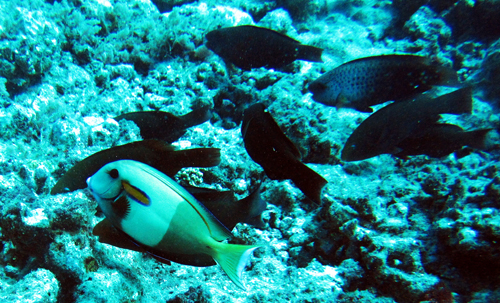We’ve all seen how algae can choke off corals in our home aquariums and the same holds true in the wild. But algae-grazing fish in the wild are doing their parts to keep algae levels low on natural reefs to allow coral spawn to settle and grow to build a thriving reef.
Scientists studied severely damaged reefs in the Caribbean with large losses of live coral and noted they soon become overgrown with algae not allowing for coral restoration to naturally take place. But reefs surrounding the South Pacific island of Moorea in French Polynesia has experienced large losses of live coral in the past and continue to bounce back, returning to a thriving coral reef.
“We wanted to know why Moorea’s reefs seem to act differently than other reefs,” says Tom Adam, postdoctoral fellow at the University of California, Santa Barbara. “Specifically, we wanted to know what ecological factors might be responsible for the dramatic patterns of recovery observed in Moorea.”
The Moorea Coral Reef Long-Term Ecological Research (MCR LTER) project examined this and Adam was a part of the research and first author of a paper published in the journal PLoS One. The research team was surprised by its findings. The biomass of herbivores on the reef—fish and other animals that eat plants like algae—increased dramatically following the loss of live coral.
“What was surprising to us was that the numbers of these species also increased dramatically,” says Andrew Brooks, co-author, deputy program director of MCR LTER, and associate project scientist with MSI. “We were not simply seeing a case of bigger, fatter fishes—we were seeing many more parrotfishes and surgeonfishes, all of whom happened to be bigger and fatter. We wanted to know where these new fishes were coming from.”
Predatory crown-of-thorn sea stars have devastated coral reefs before but the team found not all the Moorea reefs were affected the same by the sea star outbreak. The crown-of-thorns sea stars did eat most of the live coral on the barrier reef (the reef that separates the shallow lagoons from the deeper ocean). Despite this, the team found that natural disasters like cyclones and natural predation by the crown-of-thorns had little impact on the corals growing on the fringing reef that grows against the island.
“We discovered that these fringing reefs act as a nursery ground for baby fishes, most notably herbivorous fishes,” says Brooks. “With more food available in the form of algae, the survivorship of these baby parrotfishes and surgeonfishes increased, providing more individuals to help control the algae on the fore reef.
“In effect, the large numbers of parrotfishes and surgeonfishes are acting like thousands of fishy lawnmowers, keeping the algae cropped down to levels low enough that there is still space for new baby corals to settle onto the reef and begin to grow.”
Why is the Caribbean plagued with algae and dying reefs? The research suggests overfishing creating the lack of healthy populations of parrotfishes and surgeonfishes allowing the algae to run rampant. Overfishing and the protection of fish through the creation of Marine Protected Areas (MPAs), does help create populations of larger adult fish but protecting the nursery area is important to the overall health of the fish population and the reefs.
[via Futurity]




